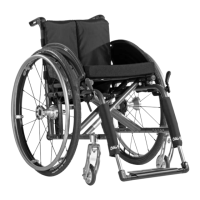59
Ensure that the anti-tipper (if mounted) is outside the
danger-area.
If possible, the foot-
plates should be ipped up before getting into or out of the wheelchair.
This can lead to falls and other dangerious situ-
ations. Therefore, familiarize yourself with the new wheelchair by practising on even, straightforward
terrain rst. Learn how the wheelchair reacts when the centre of gravity shifts; for example on slopes
or inclines or when clearing obstacles such as steps and curbs. This should be done only with assist-
ance from another person. Using an anti-tipper is strongly recommended for inexperienced wheelchair
users.
When ascending slopes or ramps and when cross-
ing obstacles on upward slopes, always lean your upper body far forward.
When reaching for objects in
front, to the side or behind the wheelchair, do not lean out of the wheelchair too far.
. Use your wheelchair
properly. Do not "jump" the chair down from higher surfaces.
All brakes acting on the tyres do not
serve as service brake but are only designed as parking brake (wheel lock). The wheel locks must not
be used as driving brakes for slowing down the wheelchair, as in extreme cases, the abrupt stopping
of the wheelchair can lead to falls.
Engage the wheel lock to prevent your wheelchair
from moving on uneven ground or during transfers (e.g. into a car).
In the dark, wear light clothing or clothing with
reectors in order to improve your visibility. Ensure that the reectors installed on the sides and rear of
the wheelchair are easily visible. We also recommend installing lights.

